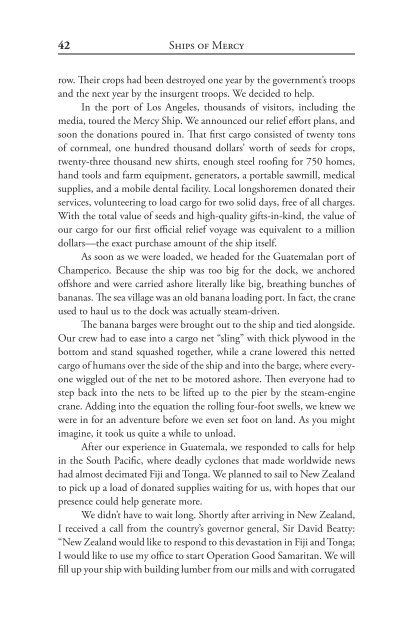You also want an ePaper? Increase the reach of your titles
YUMPU automatically turns print PDFs into web optimized ePapers that Google loves.
42 <strong>Ships</strong> <strong>of</strong> <strong>Mercy</strong><br />
row. Their crops had been destroyed one year by the government’s troops<br />
and the next year by the insurgent troops. We decided to help.<br />
In the port <strong>of</strong> Los Angeles, thousands <strong>of</strong> visitors, including the<br />
media, toured the <strong>Mercy</strong> Ship. We announced our relief effort plans, and<br />
soon the donations poured in. That first cargo consisted <strong>of</strong> twenty tons<br />
<strong>of</strong> cornmeal, one hundred thousand dollars’ worth <strong>of</strong> seeds for crops,<br />
twenty-three thousand new shirts, enough steel ro<strong>of</strong>ing for 750 homes,<br />
hand tools and farm equipment, generators, a portable sawmill, medical<br />
supplies, and a mobile dental facility. Local longshoremen donated their<br />
services, volunteering to load cargo for two solid days, free <strong>of</strong> all charges.<br />
With the total value <strong>of</strong> seeds and high-quality gifts-in-kind, the value <strong>of</strong><br />
our cargo for our first <strong>of</strong>ficial relief voyage was equivalent to a million<br />
dollars—the exact purchase amount <strong>of</strong> the ship itself.<br />
As soon as we were loaded, we headed for the Guatemalan port <strong>of</strong><br />
Champerico. Because the ship was too big for the dock, we anchored<br />
<strong>of</strong>fshore and were carried ashore literally like big, breathing bunches <strong>of</strong><br />
bananas. The sea village was an old banana loading port. In fact, the crane<br />
used to haul us to the dock was actually steam-driven.<br />
The banana barges were brought out to the ship and tied alongside.<br />
Our crew had to ease into a cargo net “sling” with thick plywood in the<br />
bottom and stand squashed together, while a crane lowered this netted<br />
cargo <strong>of</strong> humans over the side <strong>of</strong> the ship and into the barge, where everyone<br />
wiggled out <strong>of</strong> the net to be motored ashore. Then everyone had to<br />
step back into the nets to be lifted up to the pier by the steam-engine<br />
crane. Adding into the equation the rolling four-foot swells, we knew we<br />
were in for an adventure before we even set foot on land. As you might<br />
imagine, it took us quite a while to unload.<br />
After our experience in Guatemala, we responded to calls for help<br />
in the South Pacific, where deadly cyclones that made worldwide news<br />
had almost decimated Fiji and Tonga. We planned to sail to New Zealand<br />
to pick up a load <strong>of</strong> donated supplies waiting for us, with hopes that our<br />
presence could help generate more.<br />
We didn’t have to wait long. Shortly after arriving in New Zealand,<br />
I received a call from the country’s governor general, Sir David Beatty:<br />
“New Zealand would like to respond to this devastation in Fiji and Tonga;<br />
I would like to use my <strong>of</strong>fice to start Operation Good Samaritan. We will<br />
fill up your ship with building lumber from our mills and with corrugated


